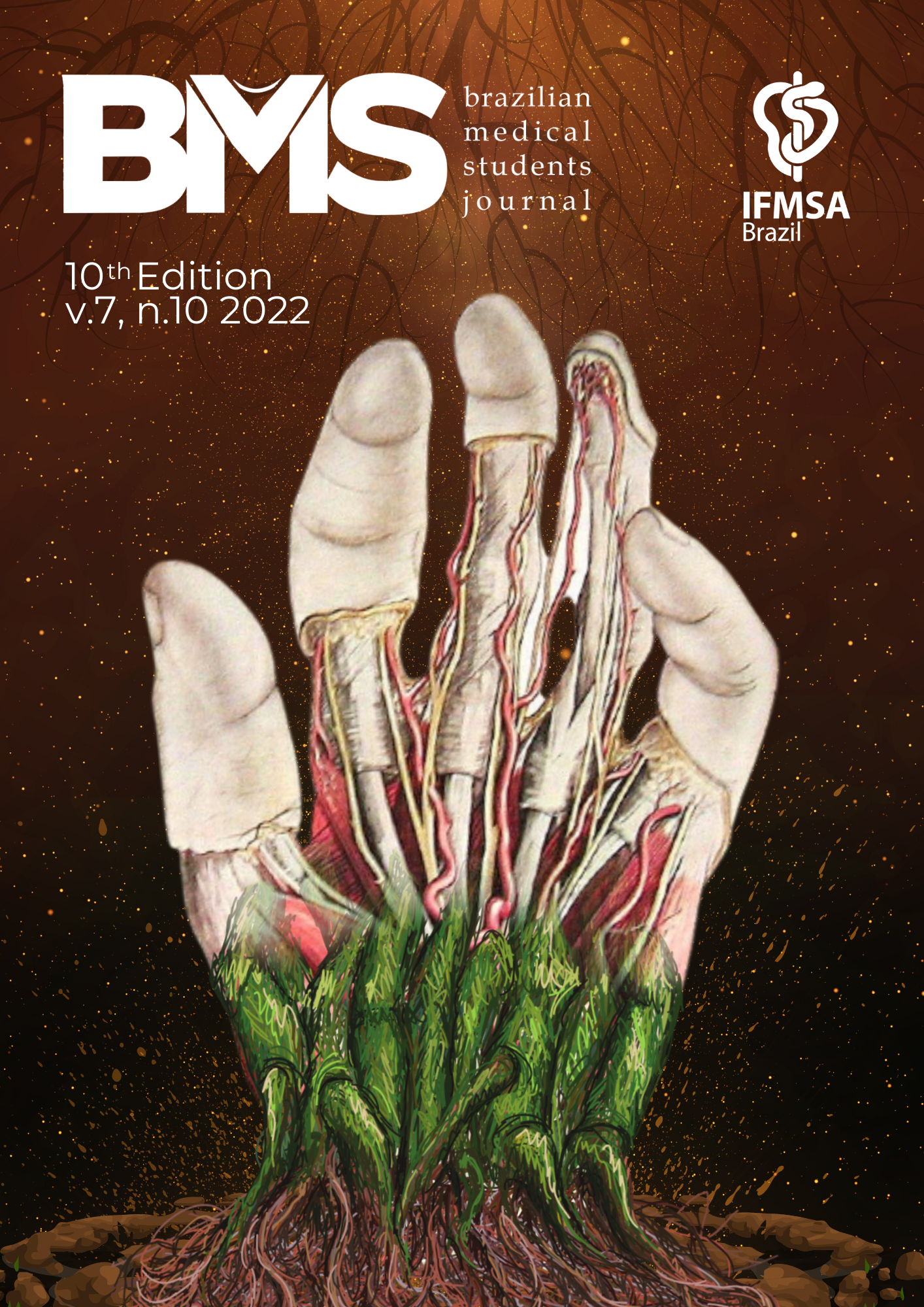HOSPITAL ADMISSIONS FOR MALIGNANT NEOPLASMS OF THE RESPIRATORY SYSTEM IN A CITY WITH A URANIUM MINE IN THE INTERIOR OF BAHIA
DOI:
https://doi.org/10.53843/bms.v6i9.237Keywords:
Respiratory Tract Neoplasm, Uranium, Radon, Primary PreventionAbstract
INTRODUCTION: Lung cancer is a type of cancer with a high fatality rate due to the lack of early diagnosis, and, therefore, there is a concern with its prevention. Among its risk factors, smoking and exposure to radon stand out, which can be formed from the decay of uranium, representing the main cause of lung cancer in non-smoker. OBJECTIVES: To compare the rate of hospital admissions for malignant neoplasia of the respiratory system from January 2008 to February 2020 in Caetité-BA, with the rate of admissions in Bahia and Southwest Bahia. METHODOLOGY: This is an epidemiological study of the ecological type, analyzing data obtained from the DATASUS database and from estimates by the Instituto Brasileiro de Geografia e Estatística for the year 2019.The data were tabulated calculated in the Microsoft Excel 2016 program. RESULTS: It was observed that in Caetité-BA there was an admission rate of 51.01/100 thousand inhabitants, while in the southwest of Bahia and in Bahia this number was 47.95 and 56.43, respectively. DISCUSSION: There was a lower rate of hospitalizations in Caetité-BA compared to the state of Bahia, but a higher rate compared to the Southwest of Bahia. Such data contradict studies that indicate a higher risk for lung cancer in regions with greater exposure to radon, however, some factors can explain this difference, such as: possible underreporting of cases and study design, since in the studies observed the comparison was made with residential radon levels. CONCLUSION: Further studies are needed to establish a relationship between the presence of uranium mines and the number of hospital admissions for malignant neoplasms of the respiratory system in Caetité-BA.
Metrics
References
Instituto Nacional de Câncer José de Alencar Gomes da Silva. Estimativa de câncer no Brasil 2020. Rio de Janeiro, 2019.
American Cancer Society. Cancer Facts & Figures 2019. Atlanta: American Cancer Society; 2019.17-19 p.
Internacional Agency for Research on Cancer. World Cancer Report: cancer research for cancer prevention. Vol. 199, Cancer Control. 2020.
Word Health Organization. Radon and Health. 2016. Acesso em agosto/2021. Acessível em: https://www.who.int/news-room/fact-sheets/detail/radon-and-health
Petta RA, Campos TFC. O gás radônio e suas implicações para a saúde pública. Geologia, v. 26, n. 02, p. 7–18, 2013. DOI: https://doi.org/10.1590/S1413-81232013000900032
Indústria nucleares do Brasil. INB Caetité volta a produzir urânio para geração de energia no Brasil, 2020. Acesso em: 12/08/2021. Acessível em: inb.gov.br.
Ruano-Ravina A, Prini-Guadalupe L, Barros-Dios JM, Abal-Arca J, Leiro-Fernández V, González-Silva AI, et al. Exposición a radón residencial y cáncer de pulmón en nunca fumadores. Resultados preliminares del estudio LCRINS. Arch Bronconeumol. 2012;48(11):405–9. DOI: https://doi.org/10.1016/j.arbres.2012.05.010
Sainz C, Dinu A, Dicu T, Szacsvai K, Cosma C, Quindós LS. Comparative risk assessment of residential radon exposures in two radon-prone areas, Ştei (Romania) and Torrelodones (Spain). Sci Total Environ [Internet]. 2009;407(15):4452–60. Available from: http://dx.doi.org/10.1016/j.scitotenv.2009.04.033 DOI: https://doi.org/10.1016/j.scitotenv.2009.04.033
Gagnon F, Courchesne M, Lévesque B, Ayotte P, Leclerc JM, Belles-Isles JC, et al. Assessment of the effectiveness of radon screening programs in reducing lung cancer mortality. Risk Anal. 2008;28(5):1221–30. DOI: https://doi.org/10.1111/j.1539-6924.2008.01105.x
Wilcox HB, Al-Zoughool M, Garner MJ, Jiang H, Klotz JB, Krewski D, et al. Case-control study of radon and lung cancer in New Jersey. Radiat Prot Dosimetry. 2008;128(2):169–79. DOI: https://doi.org/10.1093/rpd/ncm330
Bochicchio F, Forastiere F, Farchi S, Quarto M, Axelson O. Residential radon exposure, diet and lung cancer: A case-control study in a Mediterranean region. Int J Cancer. 2005;114(6):983–91. DOI: https://doi.org/10.1002/ijc.20799
Lezhnin VL, Polzik E V., Kazantsev VS, Zhukovsky M V., Pakholkina OA. A multifactorial assessment of carcinogenic risks of radon for the population residing in a Russian radon hazard zone. Arch Oncol. 2011;19(1–2):3–8. DOI: https://doi.org/10.2298/AOO1102003L
Hassfjell CS, Grimsrud TK, Standring WJF, Tretli S. Lung cancer incidence associated with radon exposure in Norwegian homes. Tidsskr Nor Laegeforen. 2017;(born 1949).
Oliveira GPD, Pinheiro RS, Coeli CM, Barreira D, Codenotti SB. Uso do sistema de informação sobre mortalidade para identificar subnotificação de casos de tuberculose no Brasil. Rev Bras Epidemiol. 2012;15(3):468–77. DOI: https://doi.org/10.1590/S1415-790X2012000300003
Additional Files
Published
How to Cite
Issue
Section
License
Copyright (c) 2022 Matheus de Moura, Iana Carneiro Pinto, Leandra da Silva Figueredo , Rebeca Magalhães Araújo, Victor Bertani Andrade, Lucas Costa Lins, Marcos Lázaro da Silva Guerreiro, Karina Souza Ferreira Maia

This work is licensed under a Creative Commons Attribution 4.0 International License.
User licenses define how readers and the general public can use the article without needing other permissions. The Creative Commons public licenses provide a standard set of terms and conditions that creators and other rights holders can use to share original works of authorship and other material subjects to copyright and certain other rights specified in the public license available at https:// creativecommons.org/licenses/by/4.0/deed.pt_BR. Using the 4.0 International Public License, Brazilian Medical Students (BMS) grants the public permission to use published material under specified terms and conditions agreed to by the journal. By exercising the licensed rights, authors accept and agree to abide by the terms and conditions of the Creative Commons Attribution 4.0 International Public License.






